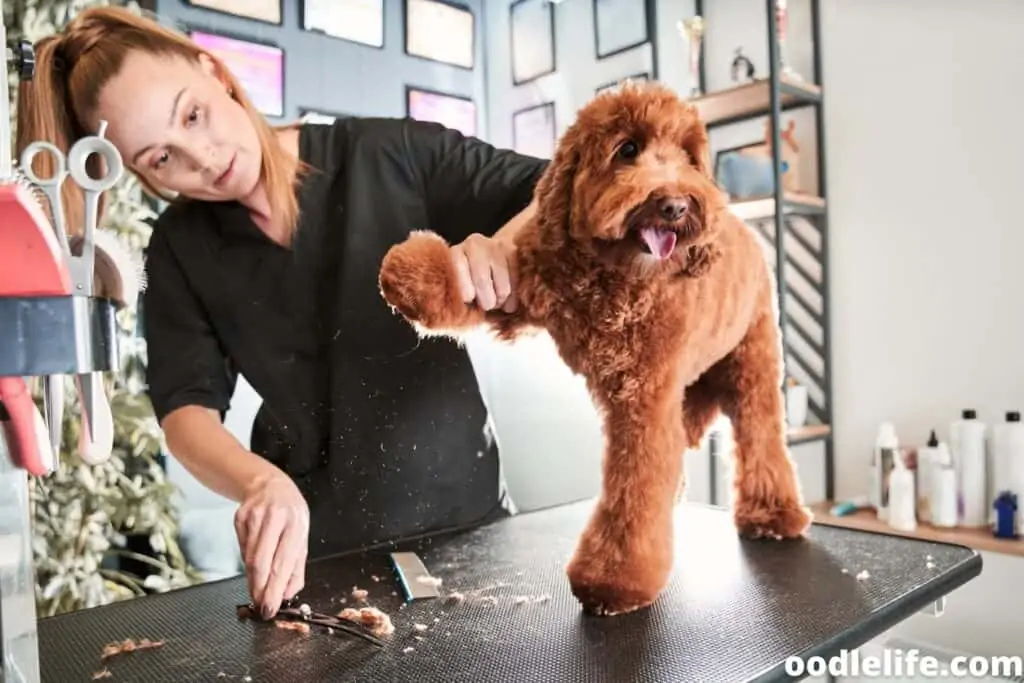How Long Do Labradoodles Live? Lifespan Guide
The life expectancy of many dog breeds depends on many factors. But smaller dogs will generally outlive their larger counterparts. Labradoodles being small breeds, live for about 12 to 15 years. Of course, some surpass this lifespan while others don’t make it past 12 years.

How Long Do Labradoodles Live?
On average, a Labradoodle lifespan is roughly 12-15 years. If your Labradoodle comes from a crossbreed of a Labrador retriever and a standard poodle, then it will live for about 12 years. But if your Labradoodle is a crossbreed of a Lab and a toy/miniature poodle, it will live longer.

According to research, mixed dog breeds outlive pure breeds by about 1.2 years. So, you can expect your Labradoodle to live longer than its parents, the Lab, and the poodle.
That said, the longevity of a Labradoodle doesn’t depend only on its genetic diversity. Several factors can shorten or extend its life expectancy. The primary factor is health problems.
Common Labradoodle Health Concerns
Despite being a mixed breed, Labradoodles can still develop health issues common to poodles and Labs. That’s why it’s vital to source your pup from reputable breeders.
Some of the health problems that affect and lower the lifespan of Labradoodles include.
Ear Infections
The American Kennel Club (AKC) approximates that 20% of all dogs contract some form of ear disease. Unfortunately, Labradoodles are part of this statistic.

Labradoodles have floppy and hairy ears, making them susceptible to ear infections. The floppy ears trap moisture and create the ideal environment for bacteria, yeast, wax build-up, and foreign objects. These elements cause different ear problems.
Most ear infections are treatable, provided you diagnose them early. However, if left unchecked, ear infections can result in permanent hearing loss. This may, in turn, decrease the life expectancy of your Labradoodle.
Some of the symptoms to look out for include:
- Ear odor
- Disorientation
- Ear scratching
- Hearing loss
- Discharge
- Scabs
Epilepsy
Labradoodles are prone to epileptic seizures. This neurological condition tends to be an inherited health problem.

Regrettably, there’s no cure for epilepsy. Your vet can only issue anticonvulsant medications if your dog continuously has seizures.
Short seizures won’t significantly impact the lifespan of your Labradoodle. However, it’s painful to watch your dog suffer.
Prolonged epileptic seizures can damage your dog’s brain and ultimately reduce its life expectancy.
Hip Dysplasia
Hip dysplasia is a common genetic problem in Labradoodles. As the dog grows, the ball and socket of its hip develop disproportionately. This causes loosening of the hip, and the bone begins to wear down. It may lead to muscle atrophy, arthritis, or limited mobility.

Your Labradoodle might have hip dysplasia if it displays any of the following symptoms.
- Reluctance to climb stairs
- Stiffness in the back leg
- Decreased thigh muscle
This painful condition won’t outrightly kill your dog. Instead, it will reduce its quality of life. If untreated, it might cripple your dog. As the owner, you may elect humane euthanasia to prevent your Labradoodle from suffering.
Von Willebrand’s Disease
This is a hereditary bleeding disorder that affects many dog breeds, including Labradoodles. It occurs due to a deficiency of von Willebrand Factor, a blood protein.

Von Willebrand’s disease prevents the blood from clotting in the usual way. That’s why dogs with this condition continuously bleed when they get injured. If left untreated, it can be fatal.
Dog’s that have this disease don’t display symptoms unless they are injured. In most cases, you should look out for signs of excessive bleeding. It could be extreme nose bleeding, blood in stool/urine, bleeding due to nail clipping, or bleeding due to surgical procedures.
Progressive Retinal Atrophy
Progressive Retinal Atrophy (PRA) can reduce Labradoodle lifespan. PRA is a degenerative eye condition that affects rod cells in the eyes.

The susceptibility of Labradoodles to PRA is because of their relationship with Labrador Retrievers.
There’s no cure or treatment for this disease. You have to live with the sad fact that your dog will be blind for the rest of its life.
Addison’s Disease
Addison’s disease is a hormonal disorder that prevents the dog from secreting cortisol and aldosterone. These two adrenal gland hormones are vital in controlling body functions.

Labradoodles that suffer from this disease may experience trouble digesting food, poor appetite, and stress management.
This disease is not curable. However, your labradoodle can live an everyday life by frequently taking replacement hormones.
Addison’s disease can be life-threatening to your dog if its cortisol levels drop significantly.
Allergies
As descendants of poodles and Labs, Labradoodles can suffer from food and environmental allergies. Food allergies are common in pups that overindulge in food like chicken. Most adult Labradoodles develop allergies when they suddenly change their diet.

Some problematic foods include:
- Corn
- Rice
- Chicken
- Wheat
- Preservatives
- Soy
Labradoodles that suffer from allergic reactions display signs like itchy skin, wheezing, stomach upsets, appetite loss, and sneezing.
Life Stages of a Labradoodle
Like other dog breeds, Labradoodles pass from puppyhood, adolescence, adulthood to seniors.
Pups (0-5 months)
Most dog owners consider Labradoodles below five months puppies. Pups that grow faster will be adolescents by the time they become five months old.
Young Labradoodles spend most of their time sleeping, suckling, and growing. As they develop, they become curious, playful and start forming bonds. It’s advisable to begin training your Labradoodle at this stage.
Adolescence (5-24 months)
Labradoodle pups become adolescents when they clock five months. They remain in this stage for about two years. During this period, hormones shape their behaviors.

Adolescents are active and will spend most of their time playing, chewing, biting, or jumping. They might show overexcitement or sometimes become aggressive. Ensure you have lots of playing toys to keep them preoccupied.
Some Labradoodles become sexually active at this stage.
Adulthood (2-9 years)
Labradoodles become fully grown adults at two years old. They remain adults until they become nine years old.
As adults, they will be much calmer and obedient. They will still be active but might start gaining weight.
In the later stages of adulthood, they will start losing their agility. You’ll notice they are stiff and become prone to bone and teeth issues. That said, they will remain healthy as long as you feed them a balanced diet.
Seniors (Over ten years)
Any Labradoodle that’s over ten years old is a senior. At this stage, it becomes prone to all manner of illnesses. So, you need to provide additional care and more companionship. Extra trips to the vet might also be necessary.

A common problem at this stage is joint pain. The pain level depends on how you train your dog and whether it has underlying conditions like arthritis. Joint issues reduce your dog’s mobility, which might lead to weight gain.
Apart from joint pain, senior Labradoodles can suffer from:
- Vision loss
- Dementia
- Hearing loss
- Kidney problems
- Gastrointestinal Issues
- Cancer
- Incontinence
Senior dogs are also vulnerable to the elements. You have to protect them from bitter colds and extreme heat.
Senior Labradoodles that don’t suffer from physical or health problems can live comfortably past 12 years.
How to Extend Labradoodle Lifespan
Several factors that affect the life expectancy of Labradoodles are within your control. Below are the things you can do to lengthen the life of this dog breed.
Pick Pups from Reputable Breeders
Most health conditions that affect Labradoodles are hereditary. It’s crucial to purchase pups whose parents don’t have genetic or health disorders.

You can only get healthy, disease-free puppies from reputable breeders. Always review the pup’s history and whether the breeder has screened it for common health issues.
Exercise Your Labradoodle
Exercises keep your Labradoodle fit and also help prevent joint problems. Labradoodles are active, energetic dogs that enjoy running and having fun. Take them out for evening runs, hikes, or even swimming sessions. Frequent workout keeps them in good shape and might increase their lifespans.

Give Them a Proper Diet
Diet plays a massive role in the lives of a Labradoodle. Any junk food you give your dog could result in obesity. According to a 2019 study, obese dogs live a shorter life than lean dogs.

Overfeeding can accelerate growth and cause conditions like joint dysplasia. Ensure you give your dog nutritious food and supplements.
Proper Grooming
Labradoodles have coats that require regular grooming. Routine hygiene care can help prevent conditions like ear infections, which affect the dog’s life expectancy.

Conclusion
A Labradoodle’s lifespan is between 12 to 15 years. But the actual longevity depends on the care you provide to your dog. A fit, healthy, happy dog will undoubtedly live longer.